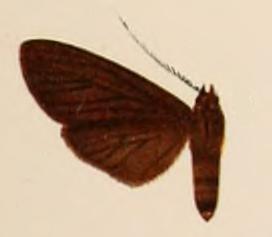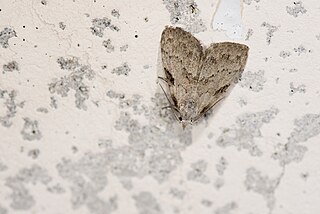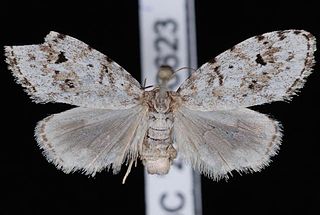Sir George Francis Hampson, 10th Baronet was an English entomologist.

Urodidae, whose species are commonly known as false burnet moths, is a family of moths in the lepidopteran order. It is the type genus in the superfamily, Urodoidea, with three genera, one of which, Wockia, occurs in Europe.

Agathiphaga is a genus of moths, known as kauri moths. and is the only living genus in the family Agathiphagidae. This caddisfly-like lineage of primitive moths was first reported by Lionel Jack Dumbleton in 1952, as a new genus of Micropterigidae.

The Thyatirinae, or false owlet moths, are a subfamily of the moth family Drepanidae with about 200 species described. Until recently, most classifications treated this group as a separate family called Thyatiridae.

Pelochyta is a genus of moths in the family Erebidae. The species was first described by Jacob Hübner in 1819. They are found in Africa, as well as throughout India, Myanmar, Sri Lanka, Australia, and New Britain.

Manoba is a genus of moths in the family Nolidae. The genus was first described by Francis Walker in 1863.

Paralephana is a genus of moths of the family Erebidae. It was described by George Hampson in 1926.
Leptepilepta is a genus of moths in the subfamily Lymantriinae. The genus was erected by Cyril Leslie Collenette in 1929.
Lomadonta is a genus of moths in the subfamily Lymantriinae. The genus was erected by William Jacob Holland in 1893.

Marblepsis is a genus of moths in the subfamily Lymantriinae. The genus was described by Hering in 1926.
Psoralis is a genus of skippers in the family Hesperiidae.
Victor Gurney Logan Van Someren was a zoologist and entomologist. Van Someren was born in Australia. He attended George Watson's College and studied zoology at University of Edinburgh. He was also a dentist. Van Someren moved to Kenya in 1912 and lived in Nairobi. He was in the East Africa and Uganda Natural History Society and became Honorary Secretary. In 1930 he became Curator of the Coryndon Museum. Van Someren named a number of bird and butterfly species.
Cyclophora umbrata is a moth in the family Geometridae. It is found in Chile.

Clemensia albata, the little white lichen moth, is a moth of the family Erebidae. It was described by Alpheus Spring Packard in 1864. It is found in eastern North America, west across boreal Canada to south-eastern British Columbia. The range extends along the Pacific Coast south to Monterey Bay in west-central California. The habitat consists of moist forests, including coastal rainforests, oak woodlands and mixed hardwood forests.
Stictane is a genus of moths in the family Erebidae erected by George Hampson in 1900.
Stictane umbrata is a moth in the family Erebidae. It was described by van Eecke in 1927. It is found on Sumatra in Indonesia.
Colla umbrata is a moth in the Bombycidae family. It was described by Schaus in 1905. It is found in the Amazon region.

Erythrodiplax umbrata, the band-winged dragonlet, is a species of skimmer in the dragonfly family Libellulidae. It is found in the Caribbean Sea, Central America, North America, and South America.






